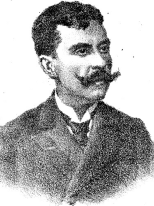U.Porto Memory
University of Porto Famous Alumni
Júlio Xavier de Matos
 |
Júlio Xavier de Matos 1856-1922 Psychiatrist and university teacher |
 Júlio Xavier de Matos was born in Porto on 26 January 1856.
Júlio Xavier de Matos was born in Porto on 26 January 1856.
He was the son of Rita Xavier de Oliveira Barros and Joaquim Marcelino de Matos (1824-1868), a journalist, writer and lawyer – who saved José Teixeira da Silva, also known as "Zé do Telhado", from the gallows, and released the writer Camilo Castelo Branco. from the Municipal Prison. He was the nephew of João Xavier de Oliveira Barros, who was a Professor in the Medical-Surgical School of Porto and the brother of Eduardo, António and Maria do Carmo Xavier de Oliveira Barros.
In 1865, his father died and he was protected by his mother's family, especially his uncles who contributed a lot to his education.
In 1874, when he was almost 18 years old, he stood out in the opening ceremony of the "Aliança Académica" students' association for giving a speech and reciting poetry.
 He studied Medicine at the Medical-Surgical School of Porto, graduating in 1880 with the inaugural thesis entitled "Pathology of Hallucinations" which he dedicated to his mother, his uncles João and Júlio Xavier de Oliveira Barros and to Dr. José Carlos Lopes.
He studied Medicine at the Medical-Surgical School of Porto, graduating in 1880 with the inaugural thesis entitled "Pathology of Hallucinations" which he dedicated to his mother, his uncles João and Júlio Xavier de Oliveira Barros and to Dr. José Carlos Lopes.
During the course, he became acquainted with Teófilo Braga (1843-1924), who would marry his sister Maria do Carmo and with whom he would collaborate scientifically.
Júlio de Matos started his practice as attending physician in the Hospital of the Alienated of Conde de Ferreira (the current Central Hospital Conde de Ferreira), soon after the opening of this psychiatric hospital in 1883, which belonged to Santa Casa da Misericórdia do Porto. After the death of its first director, António Maria de Sena (1845-1890), Júlio de Matos took charge of the institution.
In 1892, he participated in the Spanish-Portuguese-American Pedagogical Conference, invited by Bernardino Machado, where he presented a communication about "The teaching of Philosophy in Portuguese high schools".
In 1908, he signed the programme for the National Education League, and in the following year he became the director of the course of Mental Illnesses Practice.
In 1911, with the foundation of the University of Porto, he became the 1st Psychiatry Professor – a subject introduced with the 1911 reform – for the Faculty of Medicine. In the election for the first Rector, he received 3 votes.
Soon after, he was transferred to Lisbon to run the Miguel Bombarda Mental Hospital (1911-1923) and teach the recently established subject of Psychiatric Practice in the Faculty of Medicine of the University of Lisbon. Later on, he taught Forensic Psychiatry in the Higher Course of Forensic Medicine.
In Lisbon, despite focusing his professional life on the modernization of psychiatric assistance and on creating a new hospital of this specialty, he was also a member of the Senior Council for Public Education (elected in 1911) and was invited to be the minister of Public Education.
 Júlio de Matos was a writer and a celebrated critic. Co-founder and director, together with Teófilo Braga, of the periodical "Positivism: philosophy magazine", he was member of the Medical-Legal Council, of the Society of Medical Sciences, of the Academy of Sciences of Lisbon, of the Paris Société Médico-Psychologique and of the Société Clinique de Médecine Mentale.
Júlio de Matos was a writer and a celebrated critic. Co-founder and director, together with Teófilo Braga, of the periodical "Positivism: philosophy magazine", he was member of the Medical-Legal Council, of the Society of Medical Sciences, of the Academy of Sciences of Lisbon, of the Paris Société Médico-Psychologique and of the Société Clinique de Médecine Mentale.
Júlio de Matos, one of the first Portuguese readers of Darwin's works, was the author of an "Illustrated Natural History: compilation of the most competent zoological works", today considered a bibliographical rarity, where he compilled works from Buffon, Brehm, Figuier and Milne-Edwards. Among his works, those that stand out are the "Manual of Mental Illnesses" (1884, republished in 1911 under the title "Elements of Psychiatry"), "Madness: Clinical and Medical-Legal Studies" (1889), "Hallucinations and Delusions" (1892), "Paranoia" (1898), "Clinical and Medical-Legal Studies on madness" (1899), "The Calmon Issue" (1900), "The Alienated in Court" (3 vols., 1902-1907), "Assistance aux Aliénés" (1903) and "Visual Amnesia" (1906). Equally important are the communications presented in the 14th Conference of International Medicine (1903) about "Assistance to alienated criminals under the legislative point of view" and in the 15th Conference of International Medicine (1906) – "Contribution to the study of visual amnesia".
Júlio de Matos was married to Júlia Carlota de Araújo Ramos and had a daughter, Sara Xavier de Matos.
This brilliant alienist, a pioneer in the teaching of Psychiatry and in the clinical and forensic medicine studies of Psychiatry in Portugal, a reformer of psychiatric assistance (by decree of 11 May 1911), died in Lisbon on 12 April 1922 of chronic pulmonary tuberculosis.
(Universidade Digital / Gestão de Informação, 2012)
Last updated: 2016-07-06 Webpage created on: 2025-06-25 18:55:23 Complaint Portal